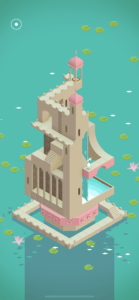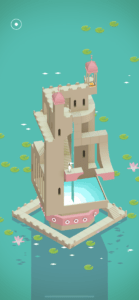I played Monument Valley, a single-player indie puzzle game developed by Ustwo Games. It is available on iOS, Android, Windows Phone, and Microsoft Windows, and I played it on iOS. The target audience is 4+.
Formal Elements + Types of Fun
Monument Valley The boundaries together with the procedure and rules of this game highly enhances the types of fun this game hopes to evoke. Unlike many other games in which the boundaries are confined by the dimensionality of the real world, Monument Valley utilizes the isometric designs of space and gives player the control of dimensionality in space. Since there are more mechanisms introduced in each level, that keeps players engaged and constantly evokes a sense of discovery and exploration since the puzzle allows the players to keep on pushing against the normal boundaries and dimensions of our real world. This further evokes a sense of challenge as well. Some extra resources of this game including each level description and the conversation with the mysterious character provides some narrative and also adds on to the fantasy type of fun.
Successes + Failures
I would say there isn’t one big success I had but I definitely had multiple small successes which I think really encourages gameplay. Amongst all the small successes I had, I would say the ones that made me feel extra triumphant was when I realized that I can move the blocks marked with hollow circles, and when I realized that I can rotate the view to connect some pathways that are actually disconnected in another perspective (see attached images below). I specifically want to compare this game to Journey, which is another game I played for this class. For Journey, I felt defeated multiple times since I’m not familiar with a lot of video game techniques (ex: mechanism of jumping/flying while still controlling where you are going), so I’m often stuck in the gameplay even though I know what I need to do clearly. I don’t like being stuck in a stage in which you know a clear path ahead but just cannot proceed due to technical difficulties. However, in Monument Valley, it is quite the opposite. I love how each mechanism itself is relatively simple – turning the wheel, moving the blocks – but the actual puzzle of proceeding ahead is what keeps players thinking.


I’m relatively early on in the gameplay stage so I have yet encountered big failures. Probably one small failure is when I was really confused to why I can’t turn the wheel. I initially thought there’s a limit to the number of times you can turn the wheel, so I got stuck on that for a while before realizing that you cannot be standing on the block that you want to turn.
What I would change
I honestly love Monument Valley so much already! But if I were to change a thing, I’ll probably make the narrative more connected to the actual gameplay. The game introduced snippets of narrative (ex: description of what the princess wants to do in each level prior to the level), but sometimes I get confused about the narrative and even wonder why the narrative exists there. For example, I remember going into the second level not knowing why the princess needs to go on a quest for forgiveness and how that leads to the actual gameplay – but again, I’m only early on in the gameplay and the game might reveal more details that would make more sense.
*update*: I researched more about Monument Valley and found out that the lead designer said the game is meant to be “compared the gameplay experience to a cross between the wonder of a toy shop and the world of The Lion, the Witch, and the Wardrobe, and its story to a symbolic “song” rather than a narrative book.” Given that, I would say maybe just change the final object you collect at the end of each level more connected to the theme/narrative of that level!



